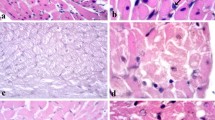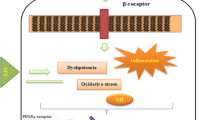Abstract
Oxidative stress plays a dominant role in the pathogenesis of diabetes mellitus. Bcl-2 gene has close connection with antioxidant stress destruction in many diseases including diabetes. Carvedilol, an adrenoceptor blocker, also has antioxidant properties. To study the effect of carvedilol on the antioxidant status in diabetic hearts, we investigated carvedilol-administrated healthy and streptozotocin-induced diabetic rats. After small and large dosage carvedilol-administered for 5 weeks, hemodynamic parameters, the levels of malondialdehyde, activities of antioxidant enzymes and expression of Bcl-2 mRNA in the cardiac tissues were measured. The diabetic rats not only had cardiac disfunction, weaker activities of antioxidant enzymes, but also showed lower expression of Bcl-2. Carvedilol treatment increased activities of antioxidant enzymes and expression of Bcl-2 in healthy rats as well as diabetic rats. These results indicated that carvedilol partly improves cardiac function via its antioxidant properties in diabetic rats.
Similar content being viewed by others
References
Amstad, P.A., Liu, H., Ichimiya, M., Berezesky, I.K., Trump, B.F., Buhimschi, I.A., Gutierrez, P.L., 2001. BCL-2 is involved in preventing oxidant-induced cell death and in decreasing oxygen radical production. Redox Rep., 6(6):351–362. [doi:10.1179/135100001101536535]
Beller, G.A., 2001. Coronary heart disease in the first 30 years of the 21st century: challenges and opportunities. The 33rd annual James B. Herrick lecture of the council on clinical cardiology of the American Heart Association. Circulation, 103(20):2428–2435.
Cai, L., Kang, Y.J., 2003. Cell death and diabetic cardiomyopathy. Cardiovasc. Toxicol., 3(3):219–228. [doi:10.1385/CT:3:3:219]
Dandona, P., Karne, R., Ghanim, H., Hamouda, W., Aljada, A., Magsino, C.H.Jr, 2000. Carvedilol inhibits reactive oxygen species generation by leukocytes and oxidative damage to amino acids. Circulation, 101(2):122–124.
Giugliano, D., Acampora, R., Marfella, R., de Rosa, N., Ziccardi, P., Ragone, R., de Angelis, L., D’Onofrio, F., 1997. Metabolic and cardiovascular effects of carvedilol and atenolol in non-insulin-dependent diabetes mellitus and hypertension. A randomized, controlled trial. Ann. Intern. Med., 126(12):955–959.
Hochman, A., Liang, H., Offen, D., Melamed, E., Sternin, H., 2000. Developmental changes in antioxidant enzymes and oxidative damage in kidneys, liver and brain of bcl-2 knockout mice. Cell Mol. Biol., 46(1):41–52.
Huang, H., Shang, J., Pan, X.H., Bao, X.F., Qian, L.B., Xia, Q., 2005. Carvedilol Protects Early Diabetic Rat Hearts through Reducing Oxidative Stress. Proceedings of the 2005 IEEE Engineering in Medicine and Biology 27th Annual Conference, Shanghai, p.339.
Jang, J.H., Surh, Y.J., 2003. Potentiation of cellular antioxidant capacity by Bcl-2: implications for its antiapoptotic function. Biochem. Pharmacol., 66(8):1371–1379. [doi:10.1016/S0006-2952(03)00487-8]
Jung, C.H., Seog, H.M., Choi, I.W., Choi, H.D., Cho, H.Y., 2005. Effects of wild ginseng (Panax ginseng C.A. Meyer) leaves on lipid peroxidation levels and antioxidant enzyme activities in streptozotocin diabetic rats. J. Ethnopharmacol., 98(3):245–250. [doi:10.1016/j.jep.2004.12.030]
Nakamura, K., Kusano, K., Nakamura, Y., Kakishita, M., Ohta, K., Nagase, S., Yamamoto, M., Miyaji, K., Saito, H., Morita, H., et al., 2002. Carvedilol decreases elevated oxidative stress in human failing myocardium. Circulation, 105(24):2867–2871. [doi:10.1161/01.CIR.0000018605.14470.DD]
Noguchi, N., Nishino, K., Niki, E., 2000. Antioxidant action of the antihypertensive drug, carvedilol, against lipid peroxidation. Biochem. Pharmacol., 59(9):1069–1076. [doi:10.1016/S0006-2952(99)00417-7]
Pieper, G.M., Jordan, M., Dondlinger, L.A., Adams, M.B., Roza, A.M., 1995. Peroxidative stress in diabetic blood vessels. Reversal by pancreatic islet transplantation. Diabetes, 44(8):884–889.
Qin, F., Shite, J., Mao, W., Liang, C.S., 2003. Selegiline attenuates cardiac oxidative stress and apoptosis in heart failure: association with improvement of cardiac function. Eur. J. Pharmacol., 461(2–3):149–158. [doi:10.1016/S0014-2999(03)01306-2]
Rosen, P., Rosen, R., Hohl, C., Reinauer, H., Klaus, W., 1984. Reduced transcoronary exchange and prostaglandin synthesis in diabetes rat heart. Am. J. Physiol., 247(4 Pt 2):H563–H569.
Shimizu, S., Eguchi, Y., Kosaka, H., Kamiike, W., Matsuda, H., Tsujimoto, Y., 1995. Prevention of hypoxia-induced cell death by Bcl-2 and Bcl-xL. Nature, 374(6525): 811–813. [doi:10.1038/374811a0]
Slikker, W., Desai, V.G., Duhart, H., Feuers, R., Imam, S.Z., 2001. Hypothermia enhances bcl-2 expression and protects against oxidative stress-induced cell death in Chinese hamster ovary cells. Free Radic. Biol. Med., 31(3):405–411. [doi:10.1016/S0891-5849(01)00593-7]
Spallarossa, P., Garibaldi, S., Altieri, P., Fabbi, P., Manca, V., Nasti, S., Rossettin, P., Ghigliotti, G., Ballestrero, A., Patrone, F., Barsotti, A., 2004. Carvedilol prevents doxorubicin-induced free radical release and apoptosis in cardiomyocytes in vitro. J. Mol. Cell. Cardiol., 37(4):837–846. [doi:10.1016/j.yjmcc.2004.05.024]
Tao, Z.W., Huang, Y.W., Xia, Q., Xu, Q.W., 2004. Early association of electrocardiogram alteration with infarct size and cardiac function after myocardial infarction. J. Zhejiang Univ. Sci., 5(4):494–498. [doi:10.1631/jzus.2004.0494]
Vincent, A.M., Brownlee, M., Russell, J.W., 2002. Oxidative stress and programmed cell death in diabetic neuropathy. Ann. N Y Acad. Sci., 959(4):368–383.
Zeng, H., Liu, X., Zhao, H., 2003. Effects of carvedilol on cardiomyocyte apoptosis and gene expression in vivo after ischemia-reperfusion in rats. J. Huazhong Univ. Sci. Technol. Med. Sci., 23(2):127–130.
Author information
Authors and Affiliations
Rights and permissions
About this article
Cite this article
Huang, H., Shan, J., Pan, Xh. et al. Carvedilol protected diabetic rat hearts via reducing oxidative stress. J. Zhejiang Univ. - Sci. B 7, 725–731 (2006). https://doi.org/10.1631/jzus.2006.B0725
Received:
Accepted:
Issue Date:
DOI: https://doi.org/10.1631/jzus.2006.B0725




